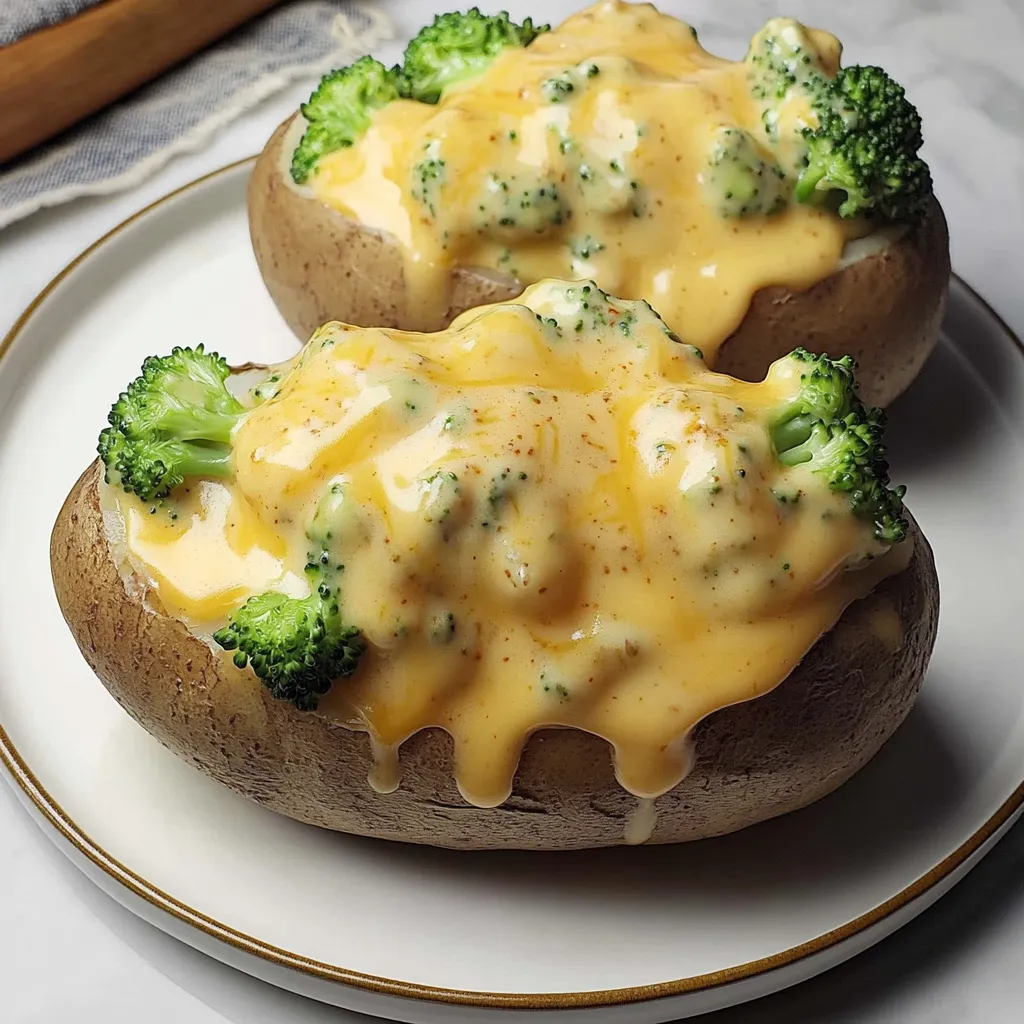 Pin it
Pin it
These broccoli cheese baked potatoes transform the humble spud into a complete, satisfying meal that delivers pure comfort in every bite. Russet potatoes bake until their interiors become impossibly fluffy while their skins develop a delightful crispness, creating the perfect vessel for a silky, flavorful cheese sauce studded with tender broccoli florets. The combination of creamy sauce, earthy potato, and fresh vegetables creates a perfect balance of textures and flavors that elevates this simple dish into something truly crave-worthy. Ready in about an hour with minimal hands-on time, these loaded potatoes prove that extraordinary meals can come from ordinary ingredients.
I discovered the magic of these loaded potatoes during a particularly hectic time when elaborate meals weren't possible but I still craved something satisfying. The first time I made them, my husband claimed they were better than the broccoli cheese potatoes at his favorite steakhouse. My children, typically suspicious of anything green, happily devoured them when I called them "cheese potatoes with little trees." Now they're requested regularly as a family favorite that manages to please everyone at the table despite different preferences. There's something deeply satisfying about a dish that transforms humble ingredients into something that feels special enough for company yet simple enough for a weeknight.
Essential Ingredients
- Russet Potatoes: These starchy potatoes are the ideal foundation for this dish. Their low moisture and high starch content creates that light, fluffy interior we crave while developing a crisp, flavorful skin during baking. Choose medium-sized potatoes (8-10 ounces each) with smooth skin and few eyes for the most consistent results and even cooking times.
- Sharp Cheddar Cheese: Provides the distinctive flavor that defines this classic combination. Aging gives sharp cheddar its robust character that stands up beautifully against the mild potato and broccoli. Always choose cheese you've grated yourself from a block rather than pre-shredded varieties, which contain anti-caking agents that prevent proper melting.
- Fresh Broccoli: Offers texture contrast, vibrant color, and nutritional balance that elevates this dish beyond simple comfort food. Fresh broccoli provides the best texture and flavor, though frozen florets can work in a pinch. The slight crispness of properly cooked broccoli creates a delightful counterpoint to the creamy cheese sauce and fluffy potato.
- Whole Milk: Creates the perfect base for a velvety, rich cheese sauce without requiring heavy cream. The fat content in whole milk allows the sauce to achieve that ideal silky consistency while carrying the flavors of cheese and seasonings throughout. Lower-fat alternatives create a thinner, less satisfying sauce.
- Butter and Flour: Work together to create a roux, the essential thickening base that transforms liquid into a luxurious sauce. Butter adds richness and flavor while flour provides structure. This classic French technique ensures your cheese sauce has body and clings beautifully to each broccoli floret.
- Spice Blend: The combination of paprika, salt, pepper, and a dash of hot sauce adds depth and character without overwhelming the dish's natural flavors. These subtle background notes elevate the entire experience from one-dimensional to complex and satisfying.
Step-by-Step Cooking Instructions
- Prepare your potatoes for optimal baking -
- Preheat your oven to 425°F. Dissolve 2 tablespoons of kosher salt in 1/2 cup of warm water in a small bowl, creating a brine solution. Thoroughly wash and scrub 4 medium russet potatoes under running water to remove any dirt or debris. Dry completely with paper towels, then use a fork to prick each potato 6-8 times, penetrating about 1/4-inch deep. This venting prevents steam buildup that could cause your potatoes to explode in the oven. Brush each potato with the salt brine solution, coating the entire surface. Place the potatoes directly on the middle oven rack with a baking sheet on the lower rack to catch any drips. Bake for 45-60 minutes, depending on size, until the internal temperature reaches 205°F or a knife slides easily through the center with no resistance.
- Prepare your broccoli perfectly -
- While the potatoes bake, trim one medium head of broccoli into small, bite-sized florets of similar size to ensure even cooking. Place florets in a microwave-safe bowl with 2 tablespoons of water. Cover with a microwave-safe plate and microwave on high for 3-4 minutes until the broccoli is bright green and tender-crisp. Be careful when removing the cover as hot steam will escape. Transfer the broccoli to a colander and allow it to cool slightly, then pat dry with paper towels to remove excess moisture. Properly dried broccoli ensures your cheese sauce remains thick and creamy rather than watery.
- Create your silky cheese sauce base -
- About 15 minutes before the potatoes finish baking, begin your sauce. In a medium saucepan over medium heat, melt 3 tablespoons of butter until it foams but doesn't brown. Add 3 tablespoons of all-purpose flour and whisk continuously for 1-2 minutes until the mixture turns light golden and smells slightly nutty. This cooking process eliminates the raw flour taste and forms the foundation for a smooth sauce. Gradually pour in 1 1/2 cups of whole milk while whisking constantly to prevent lumps from forming. Continue to whisk as the mixture comes to a gentle simmer and begins to thicken, about 3-5 minutes. The sauce should coat the back of a spoon but still flow smoothly.
- Transform into cheese sauce -
- Once the milk mixture has thickened, remove the pan from heat and add 2 cups of freshly grated sharp cheddar cheese in small handfuls, stirring after each addition until completely melted before adding more. This gradual incorporation ensures a smooth, cohesive sauce without separation or graininess. Stir in 1/2 teaspoon salt, 1/4 teaspoon black pepper, 1/4 teaspoon paprika, and 3-4 dashes of hot sauce (adjust to taste). The hot sauce adds depth without noticeable heat, enhancing the cheese flavor rather than making the sauce spicy.
- Incorporate broccoli -
- Gently fold the prepared broccoli florets into the cheese sauce until evenly coated. Keep the sauce warm over very low heat if the potatoes aren't quite ready, stirring occasionally and adding a splash of milk if it thickens too much. The goal is to maintain a luscious, spoonable consistency that will cascade beautifully over your baked potatoes.
- Finish your potatoes for maximum crispness -
- Optional but recommended: When potatoes are done baking, remove them from the oven and brush each one lightly with olive oil. Return to the oven for an additional 10 minutes to crisp the skins further. This creates that wonderful textural contrast between crisp exterior and fluffy interior that makes a truly exceptional baked potato.
- Serve immediately for optimal experience -
- Remove potatoes from the oven and immediately cut a slit lengthwise across the top of each one. Gently press the ends toward the center to open the potato and create a boat for your toppings. Fluff the interior with a fork before generously spooning the broccoli cheese sauce over each potato. For an extra touch of indulgence, top with additional grated cheese, a sprinkle of sliced green onions, or a dollop of sour cream if desired.
 Pin it
Pin it
The Art of the Perfect Baked Potato
The difference between a mediocre baked potato and an exceptional one lies in understanding the science behind potato starch and moisture. Russet potatoes contain high amounts of starch and relatively low moisture, which is why they bake up light and fluffy rather than dense and waxy.
The salt brine technique I've included might seem unusual, but it creates a noticeably better potato. The salt solution draws moisture to the surface during baking, allowing it to evaporate and leaving behind a thin salt crust that creates that prized crispy skin while seasoning it perfectly.
I discovered this method from my grandmother, who insisted that a proper baked potato should stand on its own merits even before toppings are added. She taught me to respect the potato by giving it time to bake properly—rushing results in uneven cooking with hard spots that diminish the entire experience.
During a dinner party where I served these potatoes, a friend commented that she'd never had a baked potato with such a crisp exterior and cloud-like interior. The secret, I explained, isn't fancy ingredients but proper technique—direct contact with the oven rack (never wrapped in foil), adequate pricking to release steam, and that brief final crisping with oil.
The Science of Perfect Cheese Sauce
Creating a silky, cling-to-every-bite cheese sauce requires understanding a few fundamental principles that prevent the common problems of graininess, separation, or excessive thickness.
The foundation of any great cheese sauce is a properly made roux—equal parts fat and flour cooked together until the raw flour taste disappears. This creates microscopic starch particles that disperse evenly through your liquid, thickening it without clumping. The one-minute cooking time is critical; too short leaves a raw taste, while too long prevents proper thickening.
My most valuable cheese sauce insight came after numerous failed attempts with pre-shredded cheese. The anti-caking agents that keep these convenient products from sticking together also prevent them from melting smoothly. Switching to freshly grated cheese transformed my sauce from slightly grainy to perfectly smooth and silky.
Temperature management is equally crucial—adding cheese to a bubbling hot sauce causes the proteins to seize and separate, creating a broken, oily mess. By removing the pan from heat and adding cheese gradually, you allow it to melt gently into a cohesive emulsion that won't break or become stringy.
I discovered through trial and error that placing a baking sheet under the potatoes rather than placing potatoes directly on the sheet makes a noticeable difference in texture. This allows heat to circulate completely around each potato, creating that desirable crisp skin on all sides rather than having a softer spot where it contacts the pan.
My favorite discovery came during a kitchen mishap when I was out of cheddar and substituted a combination of sharp white cheddar and smoked gouda. The depth of flavor was remarkable, prompting me to experiment with cheese combinations rather than single varieties. The lesson? Don't be afraid to use this recipe as a template for your own creativity.
These broccoli cheese baked potatoes represent what I love most about cooking—how understanding simple techniques can transform everyday ingredients into something truly special. There's a particular satisfaction in creating a dish that delivers both comfort and nourishment, that feels indulgent while incorporating vegetables naturally. In a world of complicated recipes and exotic ingredients, sometimes the most memorable meals come from perfecting the classics.
Frequently Asked Questions
- → What's the best type of potato to use?
- Russet potatoes are best because they have a fluffy texture when baked and their skin crisps up nicely.
- → Can I make this recipe ahead of time?
- Yes! Bake the potatoes and make the sauce separately, then reheat and combine when ready to serve.
- → How do I know when the potatoes are done?
- They're done when they reach 205°F in the center and a fork easily slides through with little resistance.
- → Can I add protein to this dish?
- Absolutely. Cooked bacon, diced ham, or shredded chicken all work well mixed into the cheese sauce.
- → Is there a dairy-free alternative?
- You can use plant-based butter, milk and cheese to make a dairy-free version of this recipe.
- → Can I use frozen broccoli instead of fresh?
- Yes, frozen broccoli works fine. Just thaw and drain it well before adding to the cheese sauce.
